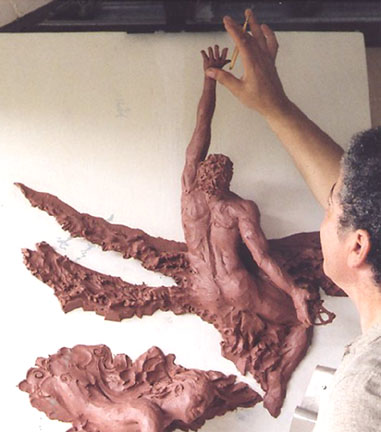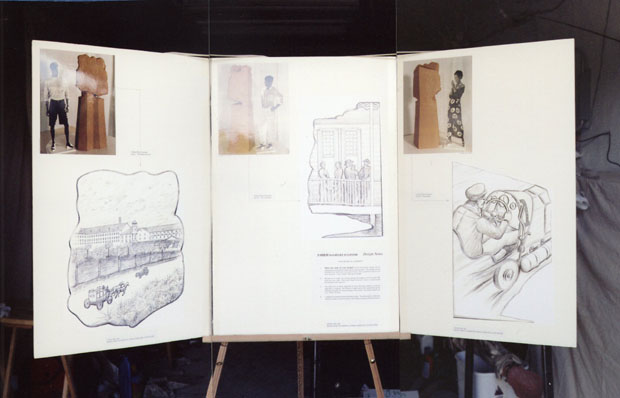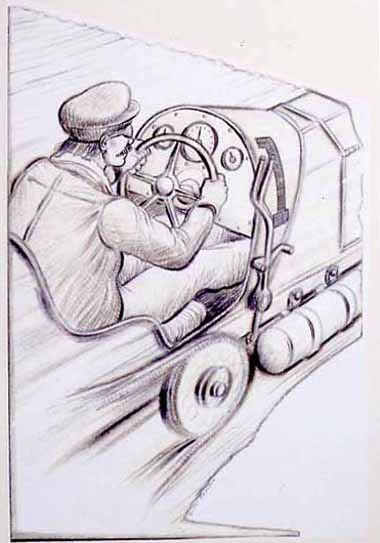| |
| Hiring a sculptor to create something new and original is fairly common. Large "public art" sculptures "commissioned" by state and local governments are the most visible of all. On the other end of the scale, portrait busts commissioned by small groups or individuals are probably the most common. The process of hiring a sculptor for these large and small commissions is quite similar. For the most part, they differ in the way the sculptor is selected, the size of the budget and the length of the contract. |
How to Hire a Sculptor - in 4 Easy Steps
1. Hire a sculptor who is a good match for your project.
Click here for more on this subject
2A. If you know what you want, then describe it in detail. Ask the sculptor what he thinks you should reasonably expect to pay based on his preliminary understanding. If he gives you a fairly wide price range, that's fine. You're not asking for an estimate at this point, you just want to see if your budget is in the ball park. If you don't have the budget, then discuss alternative methods and materials.
Click here for more on this subject.
2B. If you don't know what you want then ask the sculptor what your budget can buy.
3. If appropriate, hire the sculptor to develop a Preliminary Design in the form of detailed illustrations or a maquette (scale model). This step may be necessary, in some cases, to understand what the sculpture will really look like. The sculptor may need it to accurately anticipate all of the costs and calculate a final, realistic price.
Click here, for more on this subject.
4. Enter into a short contract that spells out the remaining details.
Click here, for more on this subject. |
More on No. 1: Hire a sculptor who is a good match for your project.
Hire a sculptor whose style suits you based on his or her previous work. He should have a portfolio of some kind and should have no problem supplying a few references, if asked.
Is the sculptor you want to hire outside of your state or region? That's not necessarily a problem. Long-distance fine art commissions are common nowadays. Many public art projects are open to artists living anywhere in the region or nation. How you deal with the factor of distance depends on the nature of your project. For example, when I do a portrait bust of a living subject I will usually travel to the subject to take my own measurements and photos. When it is time for the client to approve the clay model, they have the option of visiting my studio or approving the work on the basis of photos sent electronically. I usually create a web page for the client, a password-protected web page with photos showing the work in process including notes and talking points. Hire a sculptor who empathizes with your need to be kept informed of his progress.
Click here to see an example of a client's project page.
Do you plan to install your sculpture in a public place? On top of a building? In the center of a fountain? The sculptor should be able to answer general questions regarding safety, installation and maintenance. Will your project require substantive interaction with designers, architects or construction managers? If so, then take the sculptor's communication skills into consideration. |
More on No. 2A: See if your budget is Äúin the ball parkÄù
You just want to know how much your project will likely cost and you don't want to spend any more than necessary to achieve excellent results. But at first you may have to live with ball park numbers, especially if your project is large or complex. The sculptor is going to need detailed information from you in order to calculate a precise price. So, set aside a little time and be prepared to discuss all of your thoughts and requirements. He may have to go away and get quotes from foundries and other vendors before reporting back to you with a reasonable, defensible price. I usually start by telling the customer the price of a comparable project or a reasonable price range, to see if we are in the same Äúball parkÄù. If we are, then we can move forward. If not, then I will suggest alternate methods and materials to attempt to move closer to the client's budget. Hire a sculptor who is knowlegdable and can offer you more than one option |
More on No. 3: Hire the sculptor to develop a Preliminary Design (PD)
If you just want a portrait bust, then this step may not be necessary. If you want a unique figurative sculpture, an new award or a one-of-a-kind sculpted fountain for example, then a Preliminary Design is very much in your best interest. It clarifies everything and eliminates surprises. I usually charge a fee based on the number of hours I think IÄôll need to develop an excellent idea and the illustration or maquette. Once the client approves my PD, I can use it to get quotes from foundries, shippers and other vendors. The PD allows me to calculate a precise price. Most importantly, the PD allows you to see what the sculptor intends to do artistically and respond to the design before physical work begins. |

Example of a Preliminary Design for
"Existo"
in the form of a maquette for a life-size sculpture |

An example of a Preliminary Design in the form of Detailed Illustrations
for an historical sculpture.
The proposal shown above is 7-1/2 feet wide. |

"Beach Run"
An enlargement of the Proposal
above this photo, in the lower right-hand corner. |
More on No. 4: Enter into a short contract that spells out the remaining details.
I have worked with and without contracts with no problems, but I believe contracts are the best way to hire a sculptor. The key is to keep it reasonable, short and easy to read. A reasonable contract spells out the details, in natural language, usually in less than two pages. Usually, I will provide the contract. You donÄôt have to remember your conversations with the sculptor and review letters and e-mails, because the agreement is all in one place. You donÄôt have to pay a lawyer because the language is plain. A portrait bust commission may require a simple 1-1/2 page contract supplied by the sculptor. As the physical size and complexity of the project increases so does the length of the contract, as you would expect. Please remember this: Your relationship with the sculptor should center around mutual trust, your level of confidence and your belief that the sculptor is up to the job. Hire a sculptor that you believe in. The primary purpose of the contract is not to enforce its provisions but to make the agreement itself crystal clear.
Most sculpture commissions are governed by a type of contract known as "A Third, A Third and A Third". The payments are broken into thirds, as the name implies. The Preliminary Design is usually completed seperatly, before the contract is signed. The first payment is a "down payment" to begin physical work. The second payment is usually made when the sculptor is done modelling clay and is ready to move forward with mold-making and casting. Since mold-making and casting are irreversible steps, the client's approval is absolutely required in order to proceed and complete the sculpture in its final material. The third and final payment is made when the sculpture is delivered and is approved by the client. Hire a sculptor who respects details. |
About the Author - Brian R. Owens
Brian Owens is professional sculptor and painter. He is a "contemporary realist" with a strong background in figurative, traditional sculpture who works primarily in clay and cast bronze. He has a number of public art commissions and grants to his credit as well as numerous private clients scattered from Miami to Michigan. In 2006 Owens was awarded the Florida Artist Enhancement Grant for the fiscal year 2005 - 2006, by the Florida Division of Cultural Affairs. Owens' studio is located in central Florida just north of Orlando. |
| Back to Home Page I Back to Previous Page I Back to Top |
Brian Owens
(T) 386-956-1724
© 2004 Brian R. Owens |
|
brianowensart.com |
(T)386-956-1724 |
|